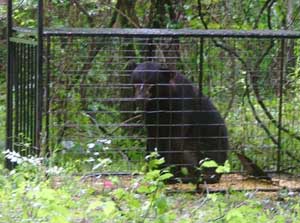Other Animals
 Black Bear Caught in Wild Pig Trap
Black Bear Caught in Wild Pig Trap
When planning and implementing a wild pig control program, always consider any potential negative effects on nontarget species. Bait items such as corn, other grains, and sweet potatoes attract not only wild pigs, but also black bear, deer, and turkey. Therefore, large nontarget species may be accidentally captured in pig traps.
Use Open-Topped Pig Traps
Natural resource professionals often recommend using open-topped pig traps, especially in areas with high potential for incidental capture of nontarget species. Some state trapping laws require that any covered pig traps have an opening in the top sufficient to allow large nontarget species to escape.
American Black Bear
The American black bear is a protected species and cannot be legally harvested in many states in the Southeast. In states where black bear harvest is legal, harvests are subject to seasonal regulations.
The Louisiana black bear, a subspecies of the American black bear, is federally protected and cannot be legally harvested at any time.
If traps with corners are used, cover only the corner
portions of the trap to reduce the opportunity for pigs to climb and escape while leaving a
large opening for nontarget animals to exit the trap.
Positively Identify Your Target When Hunting and Shooting Wild Pigs
During low-light conditions (dawn and dusk) or in dense cover, animals such as black bear, dark-colored livestock, and dogs can be easily mistaken for wild pigs. Always make positive target identification. Always be aware of your position in relation to hunting partners, public roads, buildings, and residential areas.

